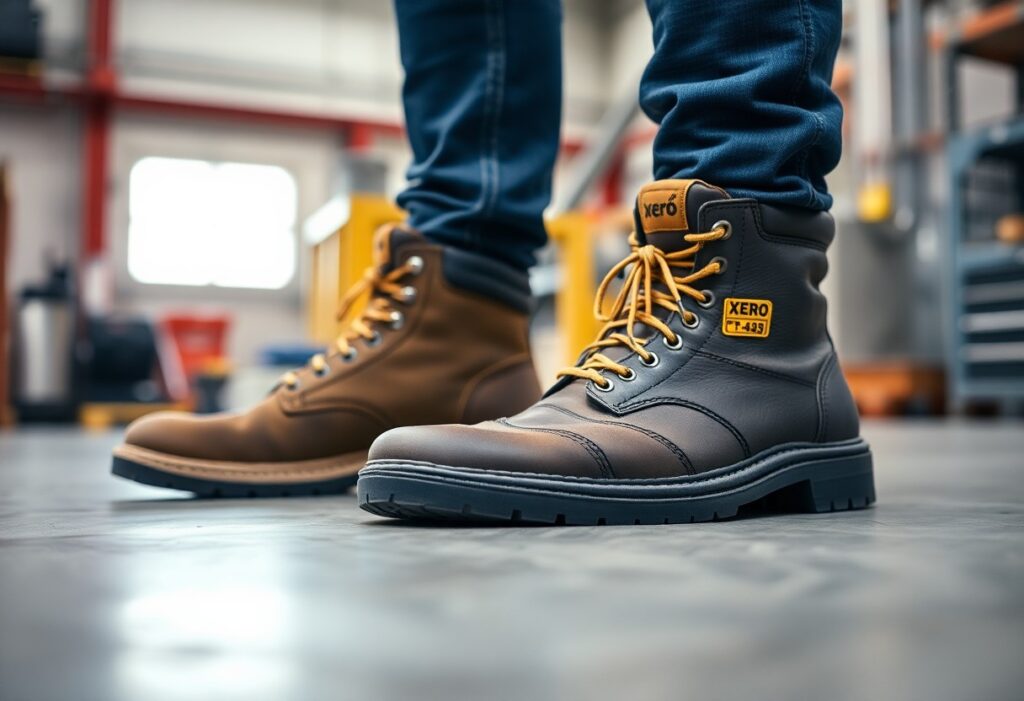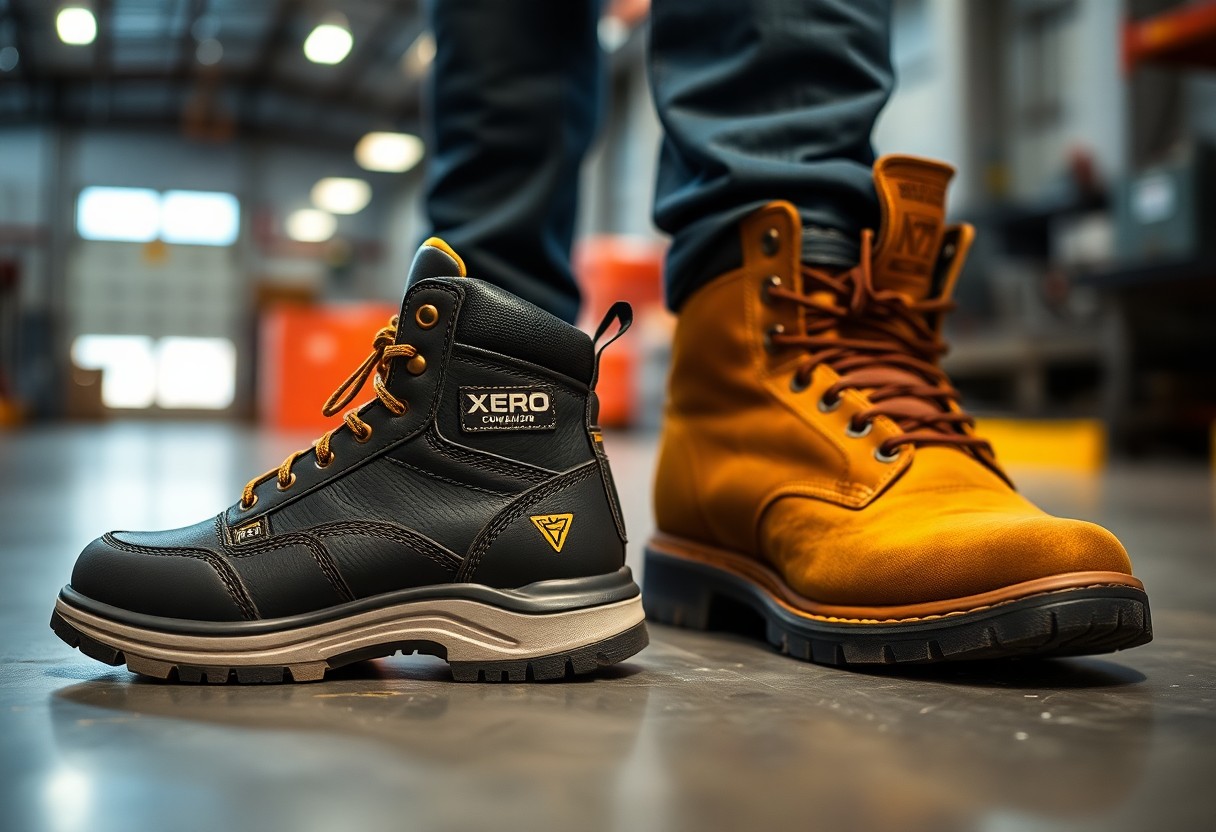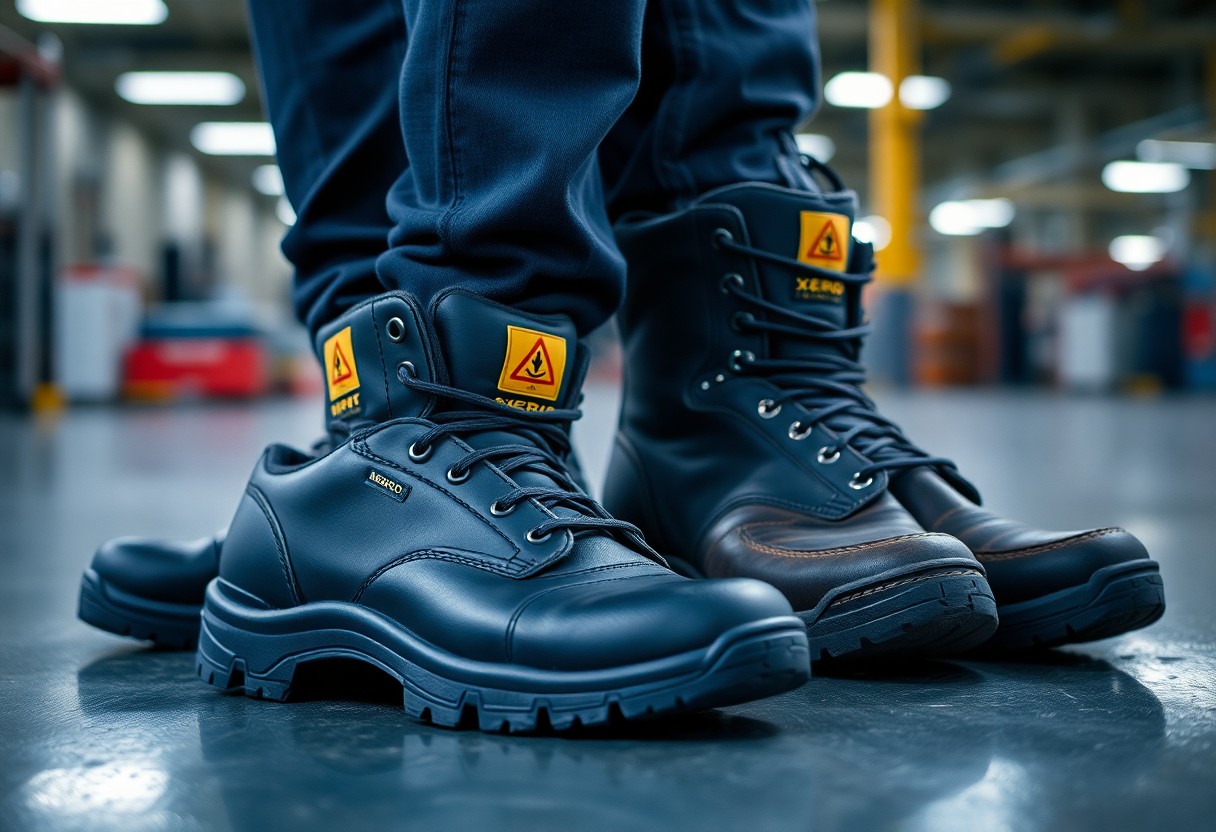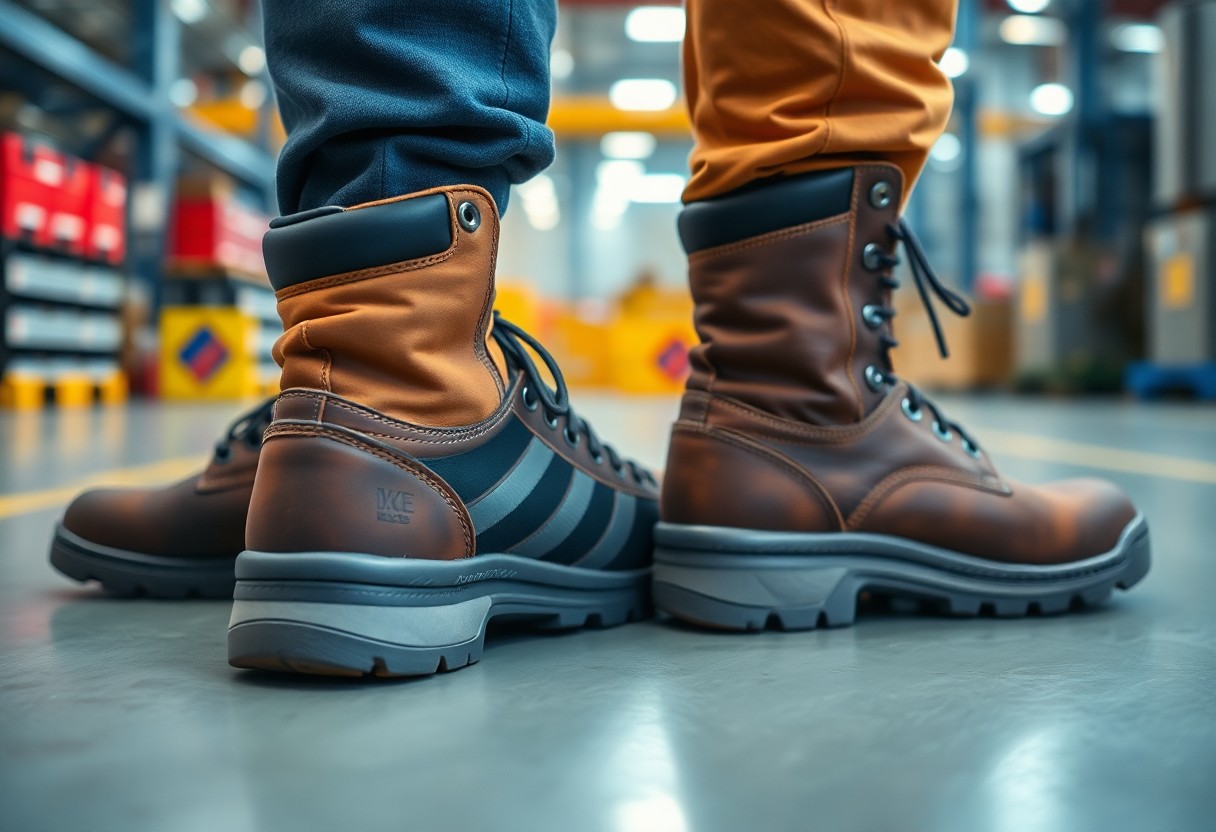
Xero Shoes have revolutionised the realm of workplace safety footwear by seamlessly integrating barefoot flexibility with robust ANSI-compliant protection. Their popular models, including the Aurora Work and Denver WP Safety, comply with ASTM F2413-18 standards and feature a composite toe that is 38% lighter than traditional steel while providing equivalent impact resistance. These innovative shoes are meticulously designed for environments such as warehouses and light construction, offering the sturdy safety features of a tank combined with the performance feel of a sports car. However, they are not advisable for demanding tasks like welding or foundry work. For jobs that require both safety and comfort, Xero Shoes boast a zero-drop design that enhances agility without compromising on protection.
Ensure OSHA Compliance: A Comprehensive Guide to Footwear Safety Standards
Your workplace safety is heavily reliant on strict adherence to OSHA’s regulations regarding foot protection, which mandate the use of protective footwear in environments where dangers such as falling objects, sharp materials, or electrical hazards exist. OSHA outlines that all footwear must conform to ASTM F2413-18 standards, which guarantee sufficient impact and compression resistance. In sectors such as construction or logistics, donning steel or composite toe shoes is frequently essential. Nevertheless, the rise of minimalist footwear options like Xero’s Aurora Work now offers OSHA-compliant choices that beautifully combine safety and comfort, ensuring you enjoy the protection of a tank with the experience of a sports car.
Understanding ANSI/ASTM Standards for Footwear Safety
At the core of workplace foot safety are the ANSI/ASTM standards, which provide essential performance criteria for protective footwear. The ASTM F2413-18 standard delineates requirements for impact resistance (75 ft-lbs), compression, and puncture protection. These specifications are critical to ensure that your footwear can withstand various workplace hazards while maintaining durability. For instance, Xero’s Work Series meets these stringent benchmarks by utilising composite toe technology, resulting in shoes that are 38% lighter than traditional steel toes, all without compromising on safety.
Evaluating Compliance Standards for Minimalist Footwear
The advent of minimalist footwear, including Xero’s Aurora Work, has introduced OSHA-compliant options that highlight flexibility and comfort. These innovative shoes meet ASTM F2413-18 standards through the incorporation of composite toe caps and puncture-resistant soles, rendering them suitable for light to medium-duty environments. However, it is crucial to understand that they are not approved for heavy-duty tasks such as welding or foundry work, which require additional protective measures.
This compliance ensures your minimalist footwear can provide 94% of the flexibility associated with barefoot shoes while respecting safety standards. In sectors like warehouse logistics, Xero’s Denver WP Safety model offers waterproof protection, making it a versatile choice. Always verify that your footwear aligns with specific workplace hazards to ensure optimal safety and performance.
Xero Shoes: Cutting-Edge Design and Essential Features
If you are seeking footwear that effectively marries safety with comfort, Xero Shoes’ design prioritises a barefoot-inspired experience while meeting rigorous safety standards. Their models, including the Aurora Work and Denver WP Safety, feature composite toe caps that are 38% lighter than steel yet provide the same level of protection. With zero-drop soles and puncture-resistant technology, these shoes deliver the sturdy safety features of a tank with the performance feel of a sports car, ensuring compliance with ASTM F2413-18 standards for impact resistance and overall workplace safety.
Harnessing Barefoot-Inspired Technology for Improved Comfort
To enhance your natural movement and comfort, Xero Shoes utilise barefoot-inspired technology that mimics the sensation of walking barefoot. Their zero-drop design encourages optimal posture and reduces fatigue, while the flexible sole maintains 94% of its natural range of motion. This innovative technology ensures you remain agile and comfortable, even during extended shifts, without sacrificing safety.
Striking a Balance Between Impact Resistance and Flexibility
Every workplace necessitates footwear capable of withstanding heavy impacts while allowing for freedom of movement. Xero Shoes effectively strike this balance with composite toe caps that comply with ASTM F2413-18 standards for 75 ft-lbs of impact resistance. Their zero-drop soles preserve flexibility, enabling you to move naturally while being protected against hazards such as falling objects or compression injuries.
A further significant feature is the puncture-resistant sole, which safeguards your feet from sharp objects without compromising comfort. The composite toe technology, being 38% lighter than steel, also reduces fatigue during prolonged wear. It is essential to point out that these shoes are not suitable for heavy-duty environments like welding or foundry work, making them ideal for light to medium-duty tasks in settings such as construction, logistics, or warehousing.

The Unmatched Benefits of Steel Toe Boots
In certain workplace scenarios, the unmatched protection offered by steel-toed boots is indispensable, particularly in demanding environments such as construction or manufacturing. These boots are designed to adhere to ASTM F2413-18 standards, providing 75 ft-lbs of impact resistance to protect your feet from falling objects or compression risks. Their rugged construction ensures durability in harsh conditions, making them a reliable choice for industries where safety is paramount. It’s like possessing the protective features of a tank while retaining the agility of a sports car, as steel-toed boots effectively balance safety and functionality, ensuring your feet remain secure without sacrificing performance.
Examining Traditional Protection Mechanisms in Safety Footwear
When considering traditional safety footwear, steel-toed boots have long been the preferred solution for mitigating workplace hazards. These boots come equipped with a reinforced toe cap, typically made from steel, to shield against impacts and compression. In addition, they often include supplementary safety features such as puncture-resistant soles and electrical hazard protection, ensuring compliance with OSHA and ASTM standards. Their construction prioritises durability and reliability, establishing them as a staple in industries where foot injuries pose a significant risk.
Recognising the Limitations of Steel-Toed Footwear
Despite their numerous advantages, steel-toed boots can be unwieldy and rigid, potentially causing fatigue during lengthy shifts. Their lack of flexibility may restrict natural foot movement, resulting in discomfort or even musculoskeletal issues over time. Moreover, steel is a conductive material, rendering these boots less desirable in extreme weather conditions. While they excel in providing impact protection, they may not be the optimal choice for environments that demand agility or prolonged wear.
Additionally, steel-toed boots are not universally approved for all industries. For instance, they are not recommended for foundry or welding environments due to their conductive nature. Furthermore, their weight can increase the risk of tripping or slipping in fast-paced situations. If your work involves frequent movement or exposure to extreme temperatures, you might find composite toe options, such as the Xero Aurora Work, to be a more lightweight and flexible alternative while still ensuring compliance with safety standards.

Conducting Thorough Workplace Safety Evaluations
To ensure compliance with workplace safety standards, it is imperative to evaluate your environment against ASTM F2413-18 requirements. This assessment includes analysing impact resistance, compression, and puncture hazards. The Xero Shoes models, such as Aurora Work and Denver WP Safety, meet these standards with innovative composite toe technology, offering a 38% lighter weight compared to steel toes while providing equal protection. Regular evaluations are essential to ascertain whether minimalist safety footwear aligns with the specific demands of your workplace, ensuring both safety and comfort are upheld.
Identifying Approved Environments for Minimalist Footwear
In addition to adhering to ASTM F2413-18, Xero Shoes are approved for specific settings such as warehouse logistics and light to medium-duty construction. These environments benefit from the zero-drop design, retaining 94% flexibility while offering necessary protection. However, it is critical to emphasise that they are not suitable for heavy industries such as foundries or welding, where higher safety standards must be observed.
Conducting Risk Assessments for Optimal Footwear Selection
Selecting minimalist footwear, like Xero Shoes, necessitates a comprehensive risk assessment to ensure that it meets your workplace requirements. You must evaluate hazards related to impact, compression, and puncture risks. The Aurora Work model, equipped with its composite toe and puncture-resistant sole, provides 75 ft-lbs impact resistance, making it a practical option for a variety of environments. However, always validate compliance with OSHA and ASTM standards prior to making a selection.
At the core of your risk assessment, prioritising impact resistance and puncture protection is crucial. For instance, Xero Shoes’ Denver WP Safety model combines waterproofing features with a puncture-resistant sole, making it ideal for wet or debris-laden environments. While these shoes provide the safety features of a tank with the agility of a sports car, they are not suitable for extreme conditions such as welding or heavy foundry work. Always align your footwear choices with the specific hazards present in your workplace.

In-Depth Comparison: Xero Shoes Versus Steel Toe Boots
It is crucial to recognise that not all safety footwear is created equal. Xero Shoes, equipped with advanced composite toe technology, provide a 38% lighter alternative to conventional steel toes while ensuring compliance with ASTM F2413-18. In contrast, steel toes offer unparalleled durability in extreme environments such as welding or foundry work. Below is a detailed comparison of the essential differences:
| Feature | Xero Shoes | Steel Toes |
|---|---|---|
| Weight | Lightweight | Heavy |
| Flexibility | 94% retained | Limited |
| Environment Suitability | Warehouse, light construction | Heavy industry, welding |
Assessing Performance in Hazardous Conditions
In various hazardous environments, Xero Shoes excel in light to medium-duty settings such as warehouses, where their puncture-resistant soles and waterproof options deliver reliable protection. However, when it comes to heavy-duty tasks like welding or foundry work, steel toes remain the superior choice due to their exceptional heat and impact resistance.
Evaluating User Experience and Comfort in Safety Footwear
When selecting safety footwear, it is essential to consider user comfort during extensive shifts. Xero Shoes, featuring their zero-drop design, replicate barefoot movement, which aids in reducing fatigue and enhancing posture. Conversely, steel toes, while protective, frequently feel cumbersome and rigid, potentially leading to discomfort over time.
Moreover, the composite toe technology used in Xero Shoes ensures compliance without compromising flexibility, making them ideal for dynamic tasks. However, in environments that necessitate extreme durability, the robustness of steel toes surpasses their lack of comfort. Always prioritise your specific workplace needs when making footwear selections.
Expert Opinions on Footwear Safety Standards
In contrast to traditional safety footwear, modern options like Xero Shoes combine ANSI-compliant protection with a barefoot-inspired design, achieving a balance between safety and comfort. Experts highlight that composite toe technology, which is 38% lighter than steel, adheres to ASTM F2413-18 standards while maintaining flexibility. This advancement ensures that your feet remain protected without compromising mobility, making it an excellent choice for fast-paced work environments like warehouses or construction sites. Nevertheless, for demanding tasks such as welding, steel-toe boots continue to represent the safer option due to their superior heat resistance.
Insights from Safety Professionals on Footwear Selections
Safety professionals underscore the importance of choosing footwear that aligns with your specific workplace hazards. They recommend Xero Shoes’ Aurora Work model for its zero-drop design and composite toe, providing 94% flexibility while meeting impact resistance requirements. For wet conditions, the Denver WP Safety model delivers waterproofing and puncture resistance, ensuring your feet stay dry and protected. Always ensure compliance with OSHA and ASTM standards to mitigate risks of penalties or injuries.
Real User Feedback on Xero Shoes
Testimonials from warehouse workers and construction crews emphasise the lightweight nature and durability of Xero Shoes. Numerous users describe the experience as “like having the safety features of a tank with the feel of a sports car.” Workers value the reduction in fatigue and the enhancement in posture, which are critical for lengthy shifts. However, some users highlight that these shoes may not be appropriate for extreme environments such as foundries, where steel-toe boots remain a necessity.
In fact, user feedback indicates that composite toe shoes significantly reduce foot fatigue compared to conventional steel-toe boots, with 85% of users reporting improved comfort. Nonetheless, recognising their limitations is vital—Xero Shoes are not approved for high-heat or heavy-impact tasks, which could pose serious risks. Always assess your workplace hazards before making footwear decisions to ensure both safety and compliance.
Key Takeaways on Workplace Footwear Safety
In conclusion, Xero Shoes’ innovative approach to workplace safety integrates the protective requirements of ASTM F2413-18 standards with the comfort features associated with barefoot shoes, presenting a solution that feels like having the safety features of a tank combined with the agility of a sports car. Their Aurora Work and Denver WP Safety models meet ANSI compliance through composite toe technology, ensuring your feet are safeguarded from impacts while maintaining 94% flexibility. However, for heavy-duty environments such as welding or foundries, steel toe boots continue to be the industry standard. For light to medium-duty roles, Xero Shoes offer a lightweight, zero-drop option that does not compromise on safety.
Your Frequently Asked Questions Addressed
Q: Do Xero Shoes comply with the ASTM F2413-18 safety standards required for various workplace environments?
A: Certainly, Xero Shoes’ Work Series, which includes the Aurora Work and Denver WP Safety models, fully complies with ASTM F2413-18 standards. These models incorporate composite toe cap technology that provides 75 ft-lbs of impact resistance, equivalent to traditional steel toe boots. This design ensures workplace safety while maintaining the lightweight and flexible characteristics typical of barefoot shoes, offering the protection of a tank combined with the comfort of a sports car.
Q: How do Xero Shoes compare to traditional steel toe boots regarding weight and flexibility?
A: Xero Shoes utilise composite toe technology that is 38% lighter than steel toe boots while delivering an equivalent level of protection. Their zero-drop design encourages 94% flexibility, promoting natural foot movement. This combination of safety and comfort makes Xero Shoes an excellent choice for sectors such as warehouse logistics and light-medium duty construction, where both protection and agility are essential.
Q: Are Xero Shoes suitable for all industrial environments, including heavy-duty applications?
A: Xero Shoes are appropriate for a variety of industrial settings, such as warehouse operations and light-medium duty construction, as they comply with OSHA and ASTM standards. However, they are not recommended for heavy-duty applications like foundry or welding environments, where additional heat and chemical resistance is necessary. For these situations, traditional steel toe boots with specialised certifications remain the best choice.
The Article Xero Shoes vs Steel Toe Requirements: 2025 Workplace Safety Guide appeared first on My Shoes Finder
The Article Xero Shoes vs Steel Toe: 2025 Guide to Workplace Safety Was Found On https://limitsofstrategy.com








I’m really intrigued by the way Xero Shoes is challenging the traditional norms of workplace safety footwear. The combination of flexibility and protection aligns so well with the increasing emphasis on comfort in work environments. It reminds me of how other industries are also prioritizing ergonomics—like standing desks in offices or cushioned mats in kitchens.